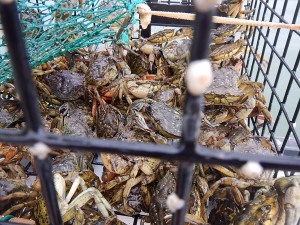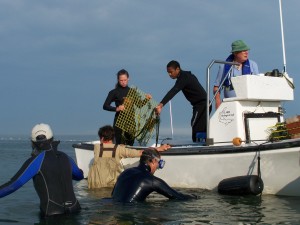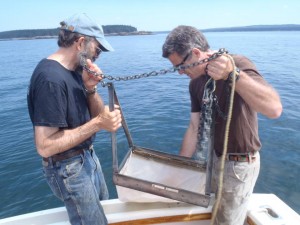The Frenchman Bay Partners (hereafter Partners) are a diverse group of people who help organizations in the watershed work together for ecosystem health and marine-based livelihoods. The Frenchman Bay Regional Shellfish Committee (hereafter Shellfish Committee) formed in 2009 in response to widespread red-tide closures to manage the intertidal mudflat resources in the 7 towns in the ordinance. The respective missions of two organizations address the long-term stewardship of the region’s resources. The two groups have been working together since 2011.
Category Archives: Partner Projects
Population Genetics of the Invasive European Green Crab, Carcinus maneas and its Role in Eelgrass Loss in the Gulf of Maine
Mary Badger, Smith College
 Abstract: In 2013, there was a devastating loss of eelgrass (Zoestra marina) in upper Frenchman Bay, Mount Desert Island, Maine. This study examined the relationship between the most recent invasion of novel haplotypes of the European Green Crab (Carnicus maneas) and the decline of eelgrass in upper Frenchman Bay. While C. maneas is an invasive species that has been present in the Gulf of Maine for over 100 years, a second invasion of C. maneas in Nova Scotia occurred during the 1980s and 1990s, bringing novel haplotypes of the species that have been cited to be more cold tolerant and voracious as compared to other haplotypes. The presence of these new haplotypes has been hypothesized to be a contributing factor to habitat destruction along the Maine coast. In 2013, northern haplotypes of green crab were documented in upper Frenchman Bay where the eelgrass had disappeared. In order to assess this relationship, the cytochrome oxidase I (COI) haplotype of the crabs at sites around Mount Desert Island was determined as well as the abundance of the eelgrass at corresponding study sites. The study did not find a significant correlation between the presence of northern green crab haplotypes and eelgrass abundance at the study sites. This indicates that the status of eelgrass health is not dependent on the genetic composition of green crabs that are present. It is more likely that factors such as green crab abundance or water quality are contributing to the declining health of eelgrass beds along the Maine coast.
Abstract: In 2013, there was a devastating loss of eelgrass (Zoestra marina) in upper Frenchman Bay, Mount Desert Island, Maine. This study examined the relationship between the most recent invasion of novel haplotypes of the European Green Crab (Carnicus maneas) and the decline of eelgrass in upper Frenchman Bay. While C. maneas is an invasive species that has been present in the Gulf of Maine for over 100 years, a second invasion of C. maneas in Nova Scotia occurred during the 1980s and 1990s, bringing novel haplotypes of the species that have been cited to be more cold tolerant and voracious as compared to other haplotypes. The presence of these new haplotypes has been hypothesized to be a contributing factor to habitat destruction along the Maine coast. In 2013, northern haplotypes of green crab were documented in upper Frenchman Bay where the eelgrass had disappeared. In order to assess this relationship, the cytochrome oxidase I (COI) haplotype of the crabs at sites around Mount Desert Island was determined as well as the abundance of the eelgrass at corresponding study sites. The study did not find a significant correlation between the presence of northern green crab haplotypes and eelgrass abundance at the study sites. This indicates that the status of eelgrass health is not dependent on the genetic composition of green crabs that are present. It is more likely that factors such as green crab abundance or water quality are contributing to the declining health of eelgrass beds along the Maine coast.
Eelgrass (Zostera marina L.) loss in Maine: An investigation into possible causes
Alden Dirks, Swarthmore College
Abstract: Eelgrass (Zostera marina L.) supplies myriad ecosystem services that make it an indispensable cornerstone of coastal environments. The complete disappearance of eelgrass in upper Frenchman Bay, Mt. Desert Island (MDI), Maine, in 2013 matched a precipitous drop in the concentration of dissolved silica (DSi). Eelgrass in outer Frenchman Bay and other locations around MDI appeared to be intact; however there were no DSi data to compare with upper Frenchman Bay locations. To investigate the relationship between eelgrass health and DSi, we determined eelgrass abundance and biomass at six locations around MDI. Furthermore, we measured dissolved nutrient concentrations in the water column as well as tensile strength and nutrient composition of tissue samples. We found a positive relationship between eelgrass abundance and biomass, and a positive relationship between biomass and the concentration of nitrite and nitrate. In addition, tensile strength was significantly different across the six sample sites. However, neither abundance nor tensile strength was significantly correlated with nutrient composition of the plants or water quality. These results reveal a deeper complexity to the issue of eelgrass abundance and tensile strength that requires further nuanced investigation into other factors such as local geography, oceanographic currents, and sediment type as they relate to eelgrass viability.
610 Project Update
The 610 Project, coordinated by Bridie McGreavy, is a collaboration between the Frenchman Bay Partners, the Frenchman Bay Regional Shellfish Committee, the Department of Marine Resources (DMR), and the Hancock County Planning Commission to build capacity towards the goal of opening closed clam flats in Frenchman Bay. A grant awarded by the Maine Community Foundation in May, 2013, has lead to substantial progress.
First, an advisory board was assembled. A harvester who conducted an extensive scoping of the status of closed clam flats was hired, relationships with representatives from DMR to identify priority closure areas that might be targeted for opening were developed, and meetings with municipal staff such as town managers and licensed plumbing inspectors to follow up on the status of problem forms related to failing septics and overboard discharge were organized.
Second, regular updates and announcements about the 610 Project are provided at the monthly meetings of the shellfish committee. Through this forum, one of the harvesters was hired to create a website for the committee: http://frenchmanbay.wix.com/fbrs. The committee also has a Facebook page: https://www.facebook.com/FrenchmanBayRegionalSHellfish.
Harvester liaison Paul Davis has conducted an extensive scoping and relationship building effort that has improved the network among different types of managers who monitor water quality, survey clams, enforce water quality violations, and who make decision about opening and closing clam flats. Through this process, conducting a watershed survey of Weir Cove has been prioritized, a step that would likely result in the identification of a pollution source(s) which would improve the ability of this group to open this important resource area . Furthermore, progress is being made on organizational capacity building. A second harvester was hired to work on the organizational infrastructure and, as mentioned above, the newly designed website will serve as an important source and repository of information for the shellfish committee. Further funding has been provided by the New England Sustainability Consortium, which will be used to hire two students to work with the advisory board and shellfish committee members to make progress on the Weir Cove watershed survey this summer, conducting preliminary scoping and initiating a plan to contact landowners.
Anecdata: Collecting observations of a changing world

MDIBL’s Community Environmental Health Lab (CEHL) rolled out its new crowd-sourced mapping tool and nature journal, Andecdata, at the Acadia National Park Science Symposium April 16. The website at www.anecdata.org is a repository for students, citizen scientists and community members to report observations of our changing environment. These reports are displayed on an interactive map and can help reveal trends, inform restoration and resource management efforts, and give users a broader understanding of their environment and the changes that are occurring due to climate change and other factors.
Green Crabs in Frenchman Bay: The Continuing Saga
Everyone has been hearing a lot about green crabs and their destructive nature these days. Frenchman Bay definitely has its share of them. Green crabs are an invasive species from Europe that were unintentionally introduced to the Eastern shores of America in the 1800s. Their numbers have been increasing ever since.

Maine Sea Grant sponsored a Green Crab Summit at University of Maine in December 2013. Many Frenchman Bay Partners were in attendance. The presentations provided a lot of detail about green crabs, their life history, and their impacts on shellfish populations and as well as salt marshes and seagrass beds. They can be viewed at http://www.seagrant.umaine.edu/green-crab-summit. Several Frenchman Bay Partners, including representatives of the Bar Harbor Shellfish Committee, MDI Bio Lab, and Frenchman Bay Regional Shellfish Committee participated in a one-day, state-wide survey of green crabs last summer, focusing their sampling efforts in Bar Harbor, Lamoine, Trenton, Sorrento and Sullivan. The results of the survey can be found on the Maine DMR website . The report concludes that green crabs are present throughout the state and in numbers that represent a detrimental impact to bivalve shellfish.
MDIBL Receives $239k Grant for Eelgrass Restoration

The U.S. Army Corps of Engineers has awarded the Mount Desert Island Bio Lab a grant of $239,000 for eelgrass restoration in Frenchman Bay. The grant will enable the Lab and its partners to restore an additional 214 acres of subtidal habitat off Lamoine, Bar Harbor, and Trenton over the next two years.
The grant is the first to be awarded in Maine under the Estuary Habitat Restoration Act of 2000 and one of only two to have ever been awarded in New England. The Army Corps grant will fund two years of restoration and research activity in Frenchman Bay and two AmeriCorps positions at MDIBL.
“With the Army Corps’ support, we will be able to ramp up our research and restoration efforts substantially,” said Jane Disney, director of the Community Environmental Health Laboratory at MDIBL and president of Frenchman Bay Partners. “Our goal is a productive and sustainable future for Frenchman Bay. By restoring eelgrass, we will improve the bay’s economic productivity as well as its biodiversity.”
Mudflat project updates
At College of the Atlantic, students have been developing protocols for measuring the pH on clamflats, and comparing different meters to see which ones are the most precise, and this fall will measure pH on several flats in Bar Harbor. One student, Katie O’Brien, has also buried clam pre-weighed clam at three different sites in look at rate of weight loss of shells as a measurement of the potential threat to clam growth from low pH on clamflats. Those clams are being collected in October and if the technique shows promise, the study will be expanded next year.
Continue reading
Diadromous fish dispatches
Frenchman Bay Partners is working closely with both the Department of Marine Resources and the Maine Inland Fish and Wildlife Service to develop fish-run restoration projects that will have the highest impact. In the last year, the groups set up monitoring on Flanders stream and examined Jones Stream as a possible next site for restoration in the bay.
Before Frenchman Bay Partners ever got started, individual partners were doing stream restoration to enhance diadromous fish populations. Sullivan resident Gary Edwards, who is now a Frenchman Bay Partner, spearheaded the Flanders Stream Alewife Restoration project, which involved opening a culvert and installing fish ladder in the stream. The project was completed this year and alewives could be seen moving up the stream in good numbers. Volunteers monitored the run, with more monitoring expected this year.
FBP draws inspiration from the success of the Somes-Meynell Sanctuary’s alewife restoration work. Alewife numbers continue to increase in the Long Pond-Somes Pond watershed, with more than 37,000 fish moving upstream this year, an increase from a few hundred fish to current levels in less than ten years. This model for stream restoration shows the type of restoration possible for small coastal streams with good connections to lakes and ponds. Some FBP partners helped with the monitoring and maintenance of this constantly improving fish run. Congratulations to the Somes-Meynell Sanctuary for leading this excellent project.
MDIBL and SMCC complete benthic survey of Frenchman Bay
During the summer of 2013, a group from Mount Desert Island Biological Laboratory and Southern Maine Community College began a benthic survey of numerous sites in Frenchman Bay. The survey was undertaken to compare current benthic species diversity with historical records collected during the first half of the 20th century.
Seven sites in Frenchman Bay were surveyed using a remotely operated vehicle fitted with a color video camera. Numerous videos were taken at each site. In addition, benthic grab samples were collected at each site and benthic species were identified and counted. The seven sites represent locations sampled by the Proctor Survey of 1926-1930. Several sites represent ledges or areas where large numbers of groundfish were historically caught by fisherman from Frenchman Bay. The project was funded by a grant from the Davis Conservation Foundation to Charles Wray. Shannon White, MDIBL Marine Specialist, and Elizabeth Thompson and Brian Tarbox from SMCC all worked collaboratively on the survey project. Data and video will be made available once it is analyzed.

